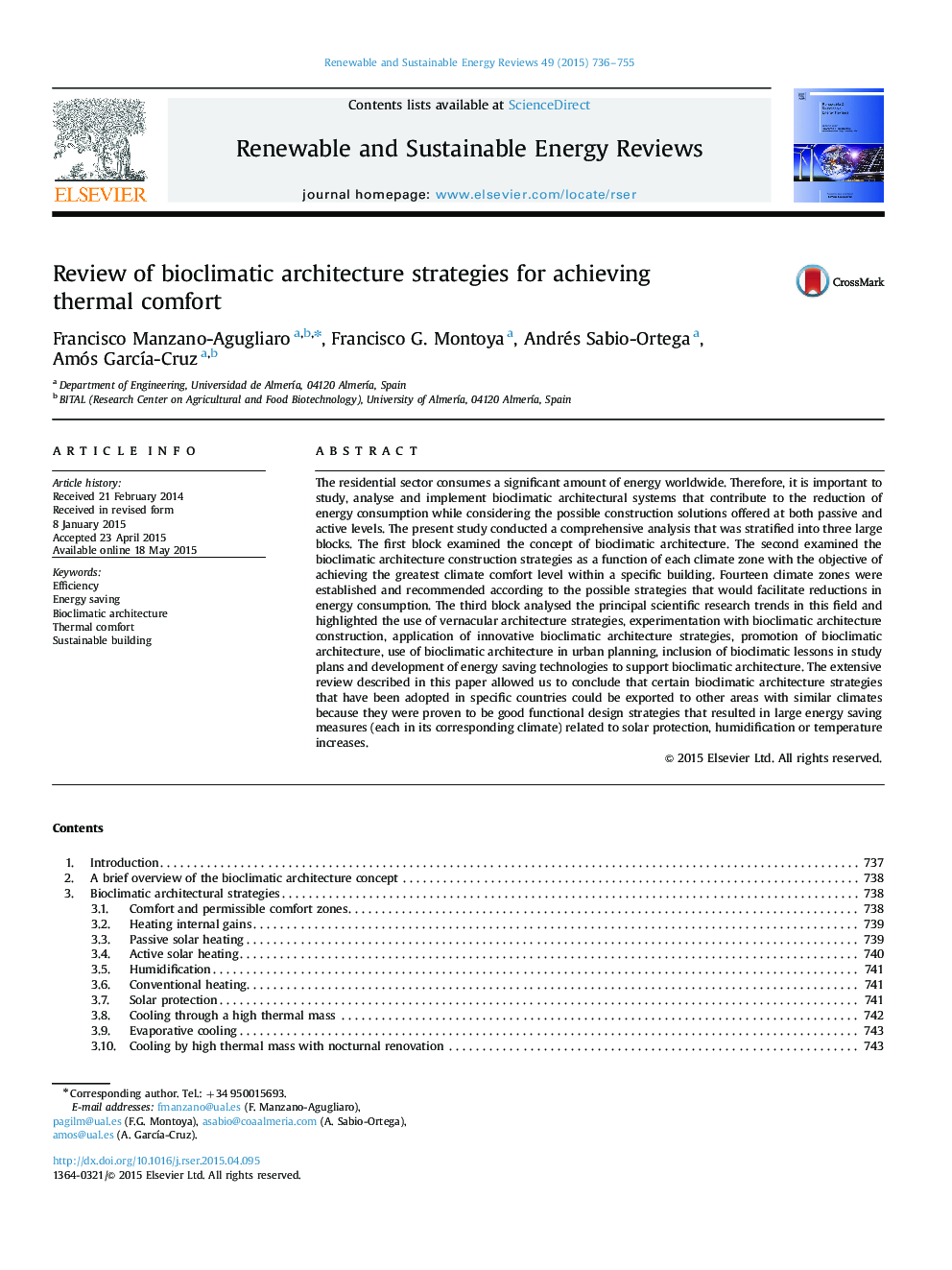| کد مقاله | کد نشریه | سال انتشار | مقاله انگلیسی | نسخه تمام متن |
|---|---|---|---|---|
| 8116769 | 1522336 | 2015 | 20 صفحه PDF | دانلود رایگان |
عنوان انگلیسی مقاله ISI
Review of bioclimatic architecture strategies for achieving thermal comfort
ترجمه فارسی عنوان
مرور راهکارهای معماری بیولوژیکی برای دستیابی به راحتی حرارتی
دانلود مقاله + سفارش ترجمه
دانلود مقاله ISI انگلیسی
رایگان برای ایرانیان
کلمات کلیدی
ترجمه چکیده
بخش مسکونی انرژی قابل توجهی در سراسر جهان مصرف می کند. بنابراین، مطالعه، تجزیه و تحلیل و اجرای سیستم های معماری بیولوژیکی کلاسیک مهم است که به کاهش مصرف انرژی در حالی که با توجه به راه حل های ممکن ساختن در سطوح غیر فعال و فعال عمل می کند، مهم است. در این تحقیق، یک تحلیل جامع انجام شد که به سه بلوک بزرگ طبقه بندی شده بود. بلوک اول، مفهوم معماری بیوکلامی را مورد بررسی قرار داد. دوم، استراتژی های ساخت و ساز معماری بیولوژیکی را به عنوان عملکرد هر منطقه آب و هوایی با هدف دستیابی به بالاترین سطح راحتی هوا در یک ساختمان خاص مورد بررسی قرار داد. چهارده مناطق آب و هوایی با توجه به استراتژی های ممکن که به کاهش مصرف انرژی کمک می کنند، ایجاد و توصیه می شود. بلوک سوم، روند اصلی تحقیقات علمی در این زمینه را مورد تجزیه و تحلیل قرار داد و با استفاده از استراتژی های معماری بومی، آزمایش با ساخت و ساز معماری بیولوژیکی، استفاده از استراتژی های معماری بیوکلامیویک، ارتقاء معماری بیولوژیکی، استفاده از معماری بیولوژیکی در برنامه ریزی شهری، درس هایی در برنامه های مطالعه و توسعه فن آوری های صرفه جویی در انرژی برای حمایت از معماری بیولوژیکی کلاسیک. بررسی گسترده ای که در این مقاله شرح داده شده است، به ما امکان می دهد تا نتیجه گیری کنیم که برخی از استراتژی های معماری بیولوژیکی که در کشورهای خاص به کار رفته اند می توانند به مناطق دیگر با اقلیدات مشابه منتقل شوند، زیرا آنها اثبات شده است که استراتژی های طراحی خوب عملکردی که منجر به صرفه جویی در انرژی شدید هر کدام در آب و هوای متناظر آن مربوط به حفاظت از خورشید، رطوبت و یا افزایش درجه حرارت است.
موضوعات مرتبط
مهندسی و علوم پایه
مهندسی انرژی
انرژی های تجدید پذیر، توسعه پایدار و محیط زیست
چکیده انگلیسی
The residential sector consumes a significant amount of energy worldwide. Therefore, it is important to study, analyse and implement bioclimatic architectural systems that contribute to the reduction of energy consumption while considering the possible construction solutions offered at both passive and active levels. The present study conducted a comprehensive analysis that was stratified into three large blocks. The first block examined the concept of bioclimatic architecture. The second examined the bioclimatic architecture construction strategies as a function of each climate zone with the objective of achieving the greatest climate comfort level within a specific building. Fourteen climate zones were established and recommended according to the possible strategies that would facilitate reductions in energy consumption. The third block analysed the principal scientific research trends in this field and highlighted the use of vernacular architecture strategies, experimentation with bioclimatic architecture construction, application of innovative bioclimatic architecture strategies, promotion of bioclimatic architecture, use of bioclimatic architecture in urban planning, inclusion of bioclimatic lessons in study plans and development of energy saving technologies to support bioclimatic architecture. The extensive review described in this paper allowed us to conclude that certain bioclimatic architecture strategies that have been adopted in specific countries could be exported to other areas with similar climates because they were proven to be good functional design strategies that resulted in large energy saving measures (each in its corresponding climate) related to solar protection, humidification or temperature increases.
ناشر
Database: Elsevier - ScienceDirect (ساینس دایرکت)
Journal: Renewable and Sustainable Energy Reviews - Volume 49, September 2015, Pages 736-755
Journal: Renewable and Sustainable Energy Reviews - Volume 49, September 2015, Pages 736-755
نویسندگان
Francisco Manzano-Agugliaro, Francisco G. Montoya, Andrés Sabio-Ortega, Amós GarcÃa-Cruz,
